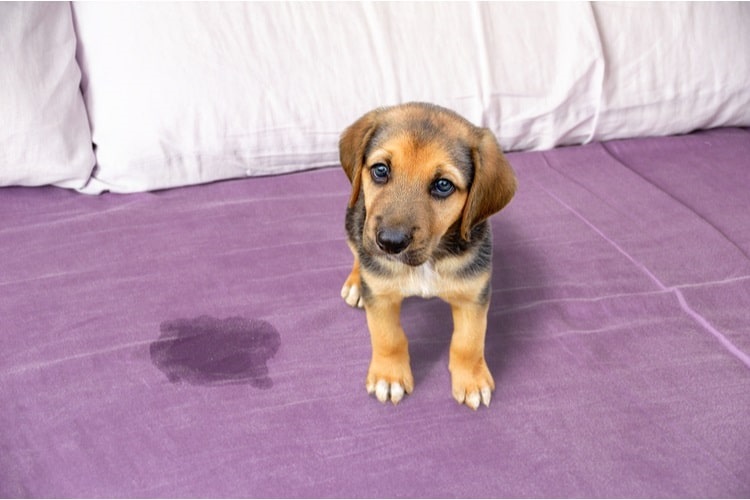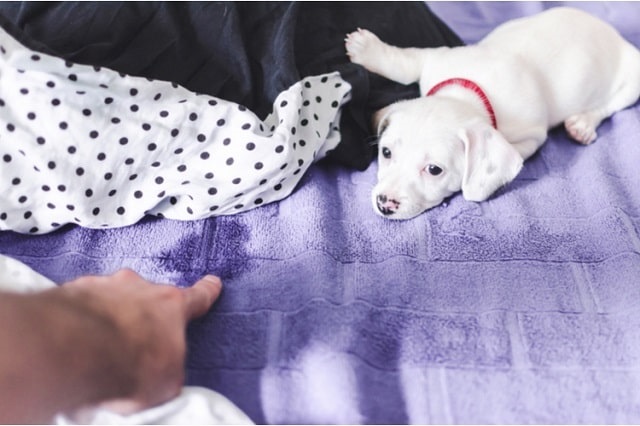Wondering what to do when your dog pees the bed? There’s nothing quite like getting ready to lay down after a long day and finding dog pee on your bed and pillow. While finding dog pee in the dog’s bed isn’t as bad, it’s still a problem that can strain your home life. Inappropriate urination usually means your dog has a medical issue or a behavioral problem. However, you can retrain your dog and put a stop to the inappropriate use of your (or your dog’s) bed and pillow.
Behavioral or Medical: Search for the Cause
It’s easy to get angry at your dog when you find pee in the bed. However, punishment isn’t the solution to the problem. In fact, it can actually make it worse. Try to look at inappropriate urination as a mystery to solve. You’ve got two basic possibilities—a medical issue or a behavioral problem.
Potential Medical Issues
If your dog was previously house-trained with no problems and suddenly starts urinating in his bed (or yours), call the veterinarian and ask if you should schedule an appointment. Most, but not all, medical issues that cause inappropriate urination have a definitive start period, whereas behavior problems tend to be on-going and then become worse.
There are plenty of medical issues that could cause your dog to have incontinence problems, including:
Medical issues that cause inappropriate urination won’t resolve themselves on their own. Your dog may need antibiotics, a diet change, or another treatment to help him get back to his usual (continent) self.
Potential Behavioral Causes
Behavioral issues like poor house training or anxiety could lie at the heart of the problem. However, your dog may simply be doing what dogs do, especially intact (non-neutered) males.5
If your dog is relatively young, he may not have fully grasped house training. Some dogs need reminder training just when you think they’ve gotten the hang of things.
Dogs who leave small amounts of urine in various places around the house could be marking their territory. This is normal behavior for dogs, especially intact males. If you find small squirts in the same places over and over again, marking is a likely culprit. Neutering can help, but more house training may be needed, too. 6
Excitement and/or separation anxiety (the line between these two can be ambiguous with dogs) could also cause your dog to pee.7 Separation anxiety is more likely the cause if you’re absent rather than present when the urination takes place.8However, a highly submissive dog may urinate in its owner’s presence when he feels anxious/excited.
How to Stop the Dog From Peeing in the Bed
Even as you’re looking for the solution to the urination problem, there are things you can do to reduce inappropriate urination. You’ll want to train your dog to pee outside, and crate training your puppy can also help.
1. Don’t Get Angry or Punish the Dog
It’s hard not to get angry when someone pees in your bed. However, anger and punishment can work against you. First, it can cause anxiety, and anxiety can lead to submissive behaviors like inappropriate urination.9 Second, it can confuse the dog. A dog may associate the anger with the act of urinating itself rather than where the urination took place.
As hard as it is, stay calm and start the process of working out the cause to ultimately solve the problem.
2. Start House Training Again
If your dog is young or forgetful, he may need some reminders on the appropriate places to urinate. Restrict your dog to a few rooms in the house where you can keep your eye on him. If you catch him starting to pee, make a reminder noise like clapping the hands or saying “no” and immediately take the dog outside to do his business.
When you’re not there to watch the dog, put him in his crate, in the backyard, or restrict him to a single room. You don’t want him to continue his bad habits when you’re not there.
3. Consider Spayed or Neutering
Males are more likely to mark than females, but both genders may mark less when they’ve been spayed or neutered.10 It’s also a good idea to do some reminder house training after the operation.
4. Waterproof Dog Bed
The type of bed you have for your dog matters when its time to prevent an accident in your bed or clean up after your pup. One bedding option is to get a waterproof dog bed. You’ll save yourself cleanup time and maybe curb some of your frustration. Less frustration can help you stay calm as you get to the bottom of your dog’s issues. You might also consider something like an elevated dog bed (to put next to your bed), an outdoor dog bed, or a dog couch bed.
Final Thoughts
Dogs follow their instincts. They don’t purposely urinate where they shouldn’t. Inappropriate urination usually indicates a more serious problem that the dog needs your help to solve. Eliminate the possibility of illness, then start the process of hours (re)training your dog so you can happily coexist. If you’re having issues training your puppy, you may also want to check out our tips on getting your puppy to sleep through the night, guide to train your dog to stay out of a room, guide to crate train your puppy, or our article on how to keep your dog out of the trash (along with our guide to choosing the best dog proof indoor trash can),
Article Sources
Pet News Daily uses only high-quality sources, including peer-reviewed studies, to support the facts within our articles. Read our editorial process to learn more about how we fact-check and keep our content accurate, reliable, and trustworthy.
- Thompson MF, Litster AL, Platell JL, Trott DJ. Canine bacterial urinary tract infections: New developments in old pathogens. The Veterinary Journal. 2011; 190(1): 22-27. doi: 10.1016/j.tvjl.2010.11.013
- Bartlett PC, Van Buren JW, Bartlett AD, Zhou C. Case-control study of risk factors associated with feline and canine chronic kidney disease. Veterinary Medicine International. 2010. Published September 20, 2010. Accessed March 25, 2021.
- Ganguly S. Canine diabetes mellitus: Diagnosis, adequate care and overall management practices involved. International Journal of Pharmacy & Life Sciences. 2014; 5(11): 4022-4023. Accessed March 25, 2021.
- Koehler, LA, Osborne CA, Buettner MT, Lulich JP, Behnke R. Canine uroliths: Frequently asked questions and their answers. Veterinary Clinics of North America: Small Animal Practice. 2009; 39(1): 161-181. doi: 10.1016/j.cvsm.2008.09.007
- Horwitz D, Landsberg G. Dog Behavior Problems Marking Behavior. Vcahospitals.com. Accessed May 3, 2021.
- McGuire, B. Effects of gonadectomy on scent-marking behavior of shelter dogs. Journal of Veterinary Behavior. 2019; 30(March-April): 16-24. doi: 10.1016/j.jveb.2018.11.002
- King JN, Simpson BS, Overall KL, et al. Treatment of separation anxiety in dogs with clomipramine: results from a prospective, randomized, double-blind, placebo-controlled, parallel-group, multicenter clinical trial. Applied Animal Behaviour Science. 2020; 67(4): 225-275. doi: 10.1016/S0168-1591(99)00127-6
- ASPCA. Separation anxiety. Aspca.org. Accessed March 25, 2021.
- Horwitz D, Landsberg G. Why Punishment Should be Avoided. Vcahospitals.com. Accessed May 3, 2021.
- McGuire, B. Effects of gonadectomy on scent-marking behavior of shelter dogs. Journal of Veterinary Behavior. 2019; 30(March-April): 16-24. doi: 10.1016/j.jveb.2018.11.002


